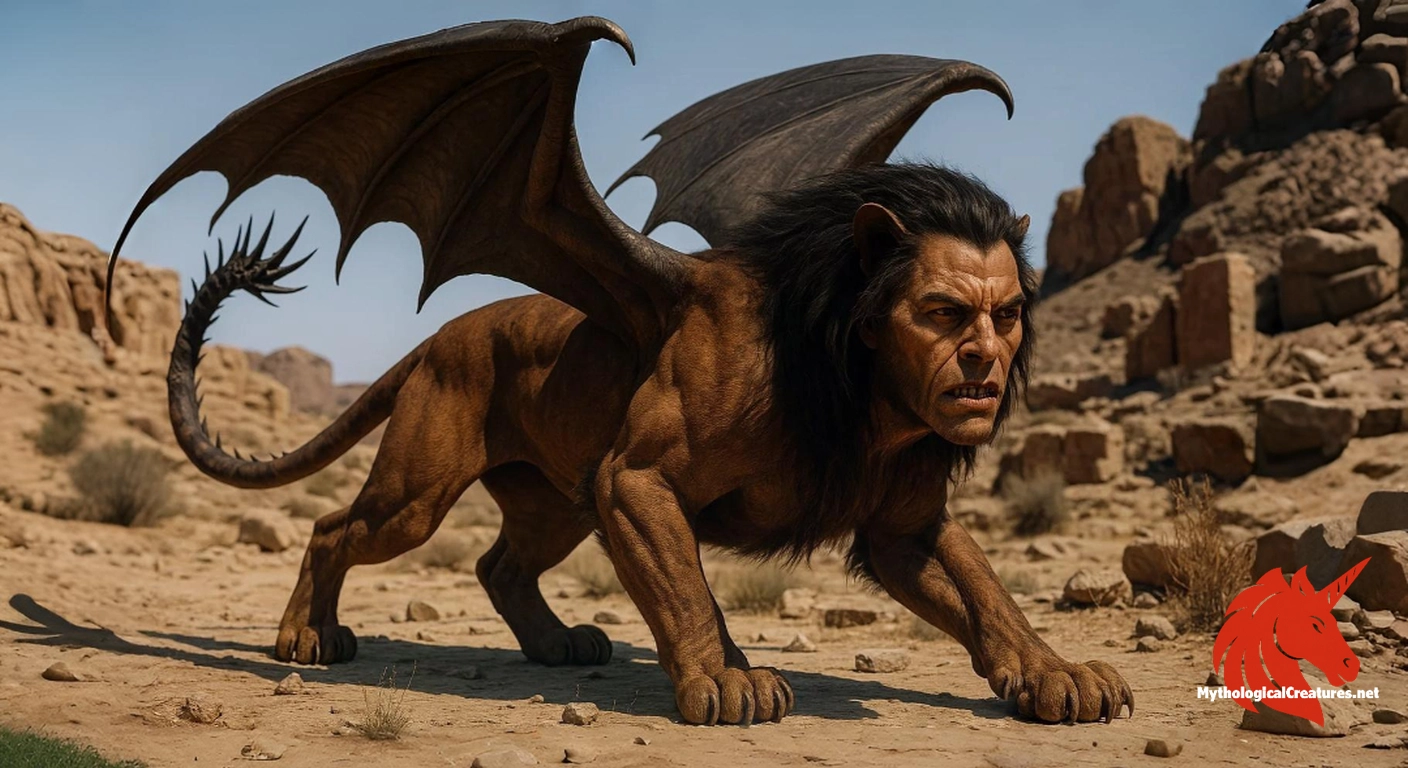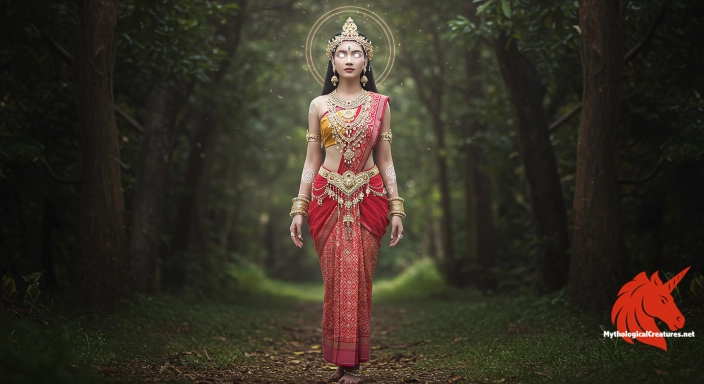Manticore: The manticore is a legendary creature from ancient Persian mythology, renowned for its composite form featuring a human face, lion body, and scorpion tail.

Manticore
Manticore - Represents the amalgamation of human ingenuity and beastly ferocity, serving as a symbol of the dangers lurking in the unknown.
Origins & First Encounters
The manticore stands as one of the most fascinating figures in ancient myth, weaving together threads of mystery and menace from early Persian folklore. Its origins are deeply rooted in ancient Persian culture, where early texts hint at a creature that bridges human intelligence with the raw force of nature. Emerging as a symbol of the wild and the unknown, it was first attested in legends that celebrated both noble and fearsome aspects of the natural world. The hybrid form of the manticore, combining a human face, a lion’s body, and a dangerous tail, symbolised the unpredictable interplay between civilisation and nature. Over the centuries, its image evolved as it travelled across cultural boundaries, absorbing new details and interpretations along the way. Its diverse depictions reflect a blend of historical influences from the Eastern traditions and later Western medieval art. The creature’s tale resonated with audiences well beyond its Persian roots, casting it as a timeless emblem of both beauty and brutality. Every retelling enriched its mystique, embedding it in a broader tapestry of myth that spoke to the dualities inherent in humanity. The legacy of the manticore continues to enchant and alarm, inviting both admiration and caution in equal measure.
Source Texts & Tale Variants
Ancient narratives about the manticore emerge from a variety of primary sources, many of which were transcribed and transformed by generations of storytellers. Early Persian texts record the creature with a blend of fearful awe and symbolic significance, setting the stage for its later mythological development. Latin translations and medieval bestiaries further embellished these accounts, incorporating additional details that amplified its terrifying attributes. In these sources, the manticore is often described with striking imagery that highlights its composite anatomy and predatory instincts. Different story variants recount its dangerous prowess through vivid and sometimes disparate portrayals, ranging from a beast with a venomous tail to one whose spines could be launched like arrows. Poetic descriptions in the ancient world emphasised its three rows of teeth and ravenous hunger, which left victims astonishingly devoid of traces. As the legend spread westward, European chroniclers added layers of dramatic embellishment that further solidified its monstrous reputation. Each retelling contributed unique elements to the manticore’s identity, ensuring that the creature remained a focus of both scholarly fascination and popular myth. The varying sources collectively underscore a legacy that is as multifaceted as it is enduring.
Form & Powers
The physical form of the manticore is a study in mythical hybridity, combining several disparate elements into one formidable creature. Its face is human, often portrayed with an expression that blends cunning intelligence with an unsettling cruelty. The lion’s body that follows suggests immense strength and regality, augmented by a muscular frame that hints at its predatory nature. A particularly striking feature is its tail, which is depicted either as a sinuous scorpion’s appendage or as being covered in venomous, porcupine-like spines. In some accounts, these spines are so potent that they may be launched like projectiles, adding a dynamic aspect to its combat abilities. Furthermore, the creature is sometimes endowed with a pair of majestic dragon-like wings that enhance its otherworldly appearance. The depiction of its three rows of sharp teeth reinforces its fearsome reputation, symbolising an insatiable appetite and unfathomable ferocity. Small variations exist in different artistic renditions, with some emphasising a more streamlined physique while others highlight exaggerated, almost supernatural features. Altogether, the manticore's anatomy is meticulously designed to evoke both awe and terror, merging beauty with lethal capability.
Regional Faces
The portrayal of the manticore shifts intriguingly as it passes through diverse cultural landscapes. In its native Persian tradition, the creature is imbued with symbolic importance, representing the enigmatic forces of the wild and the capricious aspects of fate. As it travelled through the Middle East and Central Asia, the manticore was adapted to local sensibilities, with storytellers often portraying it as both a fearsome adversary and an omen of profound change. European medieval sources, on the other hand, introduced additional draconic elements, imbuing the legendary beast with attributes that symbolised moral dualities and the clash between civilisation and savagery. In certain Indian adaptations, echoes of the manticore can be found in local mythologies where hybrid creatures serve as metaphors for the inner conflict between reason and impulse. These regional variations often manifest in subtle differences in physical depiction, such as the emphasis on wings in European accounts versus the more grounded, terrestrial depictions in Eastern traditions. Local folklore sometimes recast the creature into allegorical roles, transforming it into a moralised symbol of the dangers lurking beyond the known world. Such diversity in representation underscores the universal appeal of the manticore, permitting it to be reinterpreted in ways that resonate with distinct cultural paradigms.
Cultural Parallels
The manticore shares a number of compelling similarities with other mythological hybrids from various cultures, forging unexpected links across disparate traditions. Its combination of human intelligence and animal ferocity mirrors the duality found in the Egyptian sphinx, where a human head atop a beastly body creates a potent emblem of enigma and authority. Parallels can also be drawn with the Greek chimera, another creature of composite nature that symbolised the convergence of beauty and terror. Medieval European interpretations even likened the manticore to dragons, highlighting a merging of traits that underscored the timeless human fascination with creatures that transcended natural order. This overlap in symbolism reflects a broader cross-cultural dialogue in which the boundaries between the human and the animal, the divine and the demonic, are deliberately blurred. Similar themes emerge in the depiction of the basilisk, where lethal qualities combine with mythic grandeur to challenge conventional ideas of monstrosity. The manticore thus occupies a unique position among mythical beings, serving as a bridge between various cultural iconographies. Its enduring presence in folklore is a testament to a shared human impulse to explain the inexplicable through complex, hybrid images. In these ways, the story of the manticore continues to echo across a spectrum of mythologies, inviting comparisons that enrich its mythic tapestry.
Legacy & Modern Evolution
Over the centuries, the symbolic role of the manticore has experienced a remarkable evolution that mirrors shifts in cultural attitudes toward the mysterious and the monstrous. Originally emerging from the rich narrative traditions of ancient Persia, the manticore was initially perceived as an awe-inspiring force of nature, a living embodiment of the wild’s unpredictability. With the passage of time and the cross-pollination of mythologies, its image was reshaped within the medieval bestiaries of Europe, where it served as a potent allegory for the challenges posed by nature and the perils of moral ambiguity. During the Renaissance, its hybrid form became a subject of fascination, inspiring both literary and artistic explorations that emphasised the paradox of beauty entwined with danger. Modern interpretations in novels, films, and digital games have reimagined the manticore as a complex character, oscillating between the roles of an adversary and an enigmatic guardian of ancient secrets. Contemporary artists often portray the creature with a renewed vitality, blending historical iconography with imaginative, futuristic elements. The manticore’s enduring appeal is bolstered by its capacity to embody timeless themes, such as the tension between civilisation and the untamed natural world. Through each iterative retelling, the creature morphs to reflect evolving societal fears, values, and fascinations. Its modern legacy is thus not only one of terror but also of a rich cultural dialogue, one that continues to inspire wonder and critical reflection in equal measure.
Interesting Fact
One striking aspect of the manticore is its reputed ability to launch venomous spines like arrows, a feature that has intrigued and inspired artists and writers for centuries.
Quick Creature Info
Origin:
Features:
Our Mythic Legendary Rating:

Also Sometimes Known As:
Habitat:
Supernatural Powers:
Physical Attributes:
Abilities:
Behavior:
Lore:
References
Discover Another Mythical Legend You May Not Have Heard Of?
Uncover the mysteries of ancient folklore and expand your knowledge of legendary beings from cultures around the world.
Dare to Meet the Koujeng Leima....
Curated by the Mythological Creatures Team (rev. May 2025)
